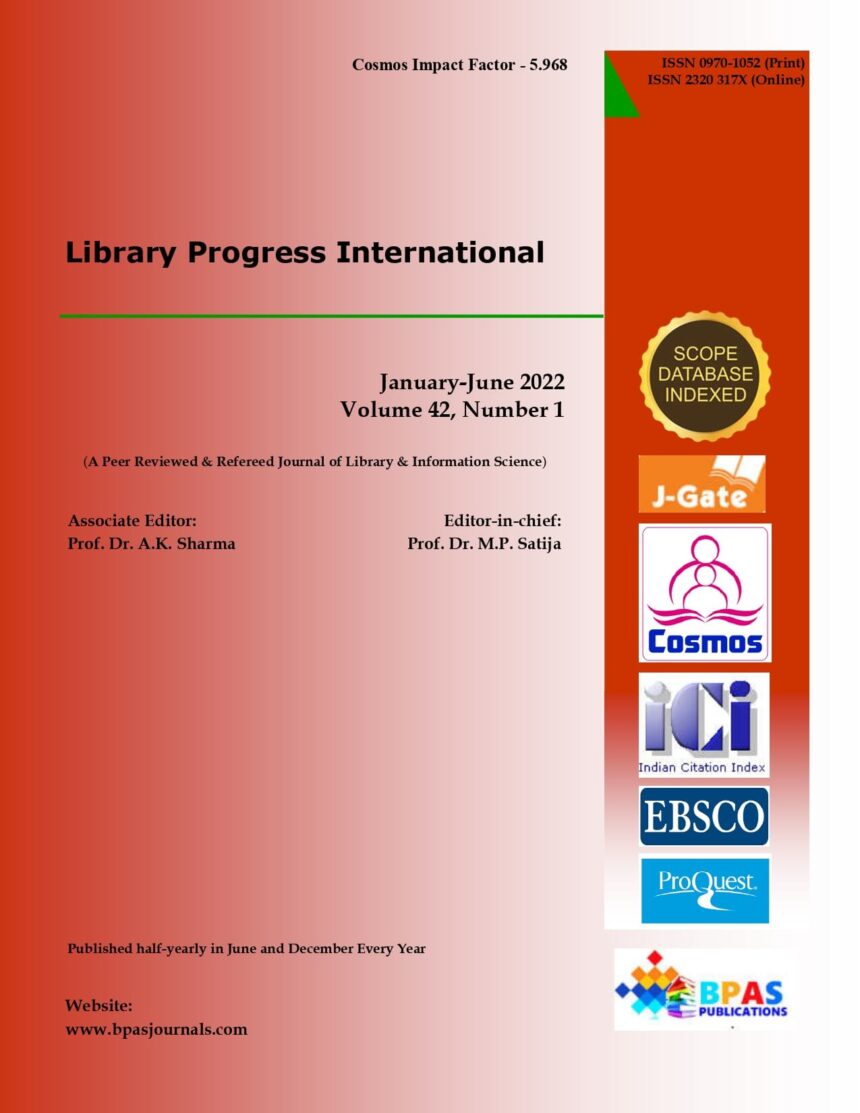Emerging Trends and Impact of Internet of Things in Academic Libraries
DOI:
https://doi.org/10.48165/bpas.2023.43.1.1Keywords:
nternet of Things, IoT, Academic Library, Educational Institute, Indian Universities, ollection Management, Machine to Machine CommunicationAbstract
The advent of smart new technologies, smart mobile connections and online services has a great impact on all aspects our life and activities. Also this advancement has many impacts on the world around us. Today, libraries and library services have great impact on the world. The aim of the current study is to introduce readers with new technologies applied to Internet of Things (IoT) that can help libraries to improve their services and increase users’ satisfaction. This study also tries to present about the possible areas of implementing the concept of IoT in academic libraries and user satisfaction on the IoT based library services and resources. Online survey from selected Educational Institutions was conducted and Data collected from a survey of a sample of 183 library users to analyse the importance and satisfaction of IoT based services and resources. Possible areas for implementing IoT in libraries - improve access to the library and its resources, collection management, recommendation service, location-based service, appliances management, usage statistics, and information literacy. The IoT technology will notify and fulfils the user-related queries through on internet i.e., self-check-in, self-check-out, overdue reminders, online fine payment, misplaced books on shelves, etc. The study observed that the maximum number of respondents used WhatsApp and Facebook respectively. Meantime, the libraries should concentrate more on interaction through videoconferencing like, Google Meet, Zoom etc. and library tutorial. 73% of the respondents are highly using the Swayam and the second highest is e-Pathshala with 48%. The institutes provide remote based library resources and services through cloud-based access on the basis of IoT i.e. Deep knowledge – remote access, Bookshelf - Mobile App and Ezproxy –Server. Most of the higher educational institutes prefer to subscribe the Deep knowledge portal on the basis of users’ satisfaction. In IoT based modern library services, it is understood that three parameters such as Academic Performance Support and Infrastructure are having significant association with the satisfaction level of 5% and training is having significant association with the satisfaction level of 1% respectively. IoT based library services and resources can be implemented in the all sections of libraries functions and services i.e. collection management, Library Marketing services, Information literacy programs, effective utilization of online learning portals, accessing of library resources, etc. ICT and Information literacy should be compulsorily included as part of the curriculum in order to equip the students and faculties for face the current digital IoT environment efficiently.
Downloads
References
Abdoulaye, K., & Ramaiah, C. K. (2019). The Internet of Things: Opportunities and Challenges for libraries. Library Philosophy and Practice (e-journal), 1-11. Retrieved from
https://digitalcommons.unl.edu/libphilpra c/3704
Abo-Seada, A. (2019). The Impact of the Internet of Things on Libraries and Users. Computers in Libraries, 39(1), 18–21.
Addepalli, S., & Addepalli, S. (2014). Library Management System Using RFID Technology. International Journal of Computer Science and Information Technologies, 5(6), 6932–6935.
Ashton, K. (2009). That “Internet of Things” Thing. Retrieved October 25, 2022, from http://www.rfidjournal.com/articles/view ?4986
Bayani, M. S. (2017). IOT-Based library Automation and Monitoring System: Developing an implementation Framework of implemental. e-Cienias de la information, 8(1), 94-111.
Canuel, R. a. (2015). Leveraging apps for research and learning: A survey of Canadian academic libraries. Library Hi Tech, 33(1), 2– 14.
CISCO. (2016). CISCO: Extending life-saving communications,. (CISCO) Retrieved OCT 25, 2022, from http://ipv6.cisco.com/web/strategy/docs/
alaska-dot-ioe.pdf,
Elangovan , A., & Radhakrishnan , N. (2020). Internet of Things and Libraries: An Empirical Study of Selected Educational Institutions in United Arab Emirates. Library Philosophy and Practice (e-journal), 1-8. Retrieved from https://digitalcommons.unl.edu/libphilpra
c/3912
Guo, Y., Liu, Y., & Bielefield, A. (2018). The provision of mobile services in US urban libraries. Information Technology and Libraries, 37(2), 78–93.
Hahn, J. (2017). Location Services Technology and the Internet of Things. Library Technology Reports, 53(1), 17–22.
Hu, J., & Zhang, Y. (2016). “Chinese students’ behavior intention to use mobile library apps and effects of education level and discipline”. Library Hi Tech, 34(4), 639– 656.
Kerr, A., & Pennington, D. (2018). Public library mobile apps in Scotland: views from the local authorities and the public. Library Hi Tech, 36(2), 237–251.
Linnik, I. (2019). The state of the Internet of Things in the Middle East. Celadon.
Mahdi , M., & Mehri Ezadi, Y. (2018). IOT: Applied New Technology in Academic Libraries. International Conference on Distributed Computing and High Performance Computing (DCHPC-2018), (pp. 1-12). Oom, Iran.
Makori, E. (2017). Promoting innovation and application of internet of things in academic and research information organizations. Library Review, 66 (8–9, ), 655–678.
Nag, A., & Nikam, K. (2016). Internet Of Things Applications In Academic Libraries. Retrieved October 25, 2022, from International Journal of Information Technology and Library Science, Vol. 5: http://www.ripublication.com
Paraschiv, P. (2019). 10 innovative technologies to implement at the library of the future”. Princh.
Paraschiv, P. (2018). Modern libraries: Moving from a transactional to a relational library. Retrieved October 25, 2022, from Princh Blog: https://princh.com/modern libraries-from-a-transactional-to-a
relational-library/#.XeHhLegzbIV
Pujar, S., & Sathyanarayana, K. (2015). Internet of things and libraries. Annals of Library and Information Studies, 62(3), 186– 190.
Qin, J. (2018). The Research of the Library Services Based on Internet of Things. Advances in Social Science, Education and Humanities Rsearch, 89, 412–420.
Ryan, P., & Watson, R. (2017). Research Challenges for the Internet of Things: What Role Can OR Play? Systems, 5,. Retrieved from
https://doi.org/10.3390/systems5010024. 22. Techopedia,. (2015, 4 10). Internet of Things,. Retrieved 10 25, 2022, from http://www.techopedia.com/definition/28 247/internal – of-things-iot,
Wei, Q., Chang, Z., & Cheng, Q. (2015). Usability study of the mobile library App: an example from Chongqing University. Library Hi Tech, 33(3), 340–355.

